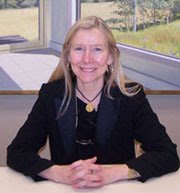 Vermont’s long-time State Archeologist has been named State Historic Preservation Officer and Director of the Vermont Division for Historic Preservation. Giovanna Peebles will assume the post immediately, according to Kevin Dorn, Secretary of the Vermont Agency of Commerce and Community Development.
Vermont’s long-time State Archeologist has been named State Historic Preservation Officer and Director of the Vermont Division for Historic Preservation. Giovanna Peebles will assume the post immediately, according to Kevin Dorn, Secretary of the Vermont Agency of Commerce and Community Development.
“Giovanna Peebles has served the people of Vermont as State Archeologist since 1976. Her long experience in this field and in historic preservation overall, as well as her passion for our state’s extraordinary heritage, makes her well-qualified to take over as State Historic Preservation Officer for Vermont.”
As State Historic Preservation Officer, or SHPO, Peebles, is responsible for administering the state’s historic preservation program under the federal National Historic Preservation Act and under the Vermont Historic Preservation Act.
“I’m looking forward to continuing the important work of the Division for Historic Preservation in helping keep Vermont the special place that it is,” Peebles said. “Vermont’s people are deeply connected with the history of their state and their own community, and they value and are proud of that heritage. Historic preservation is a large part of what makes Vermont look like Vermont and I’m honored to continue serving Vermonters in this new capacity.”
Historic preservation is also an important economic development tool, Peebles said, noting that money spent on the rehabilitation of historic buildings benefits the state’s economy as local contractors often perform the work.
Peebles takes over from acting SHPO Nancy Boone, who had held the position since 2008 when Jane Lendway, who had led the Division for Historic Preservation since 2003, retired after 33 years in state service.
Peebles, 58, of Montpelier, joined the Division for Historic Preservation, part of the Vermont Agency of Commerce and Community Development, in 1976 as Vermont’s first State Archeologist.
She has undergraduate and graduate degrees in anthropology, respectively, from Cornell University and Idaho State University and has published numerous scholarly works and has given many presentations on various aspects of Vermont archeology and history locally and nationally. Peebles is currently a candidate for a PhD in anthropology at the University of Massachusetts, Amherst.
Her dissertation centers on a recent initiative for which she received a national grant to create a prototype Internet-based Vermont archeology “museum” to share the wealth of information about the state’s 12,000-year-old history.
During her tenure she has been a passionate advocate for Vermont archeology, working from the beginning with federal and state agencies, non-profits, developers, and landowners to develop processes to protect archeological sites and sensitive lands whenever possible.
Recently she helped establish the Vermont Archaeology Heritage Center in South Burlington, where a large portion of the state’s collections of artifacts, many of which had been held out of state, can be accessed by students and scholars in one place.
The Division for Historic Preservation currently has 12 full-time staff and includes grant and technical assistance programs devoted to the rehabilitation and continued use of historic buildings- protection and interpretation of archeological resources- assistance to communities, developers, and landowners- administration of the 10 state-owned historic sites- and heritage education.
 Please join us in welcoming Carol Kammen as our third new contributor here at New York History. Kammen is Tompkins County Historian, a Senior Lecturer at Cornell University, and the author of several books including On Doing Local History: Reflections on What Local Historians Do, Why, and What It Means and The Peopling of Tompkins County: A Social History.
Please join us in welcoming Carol Kammen as our third new contributor here at New York History. Kammen is Tompkins County Historian, a Senior Lecturer at Cornell University, and the author of several books including On Doing Local History: Reflections on What Local Historians Do, Why, and What It Means and The Peopling of Tompkins County: A Social History.

